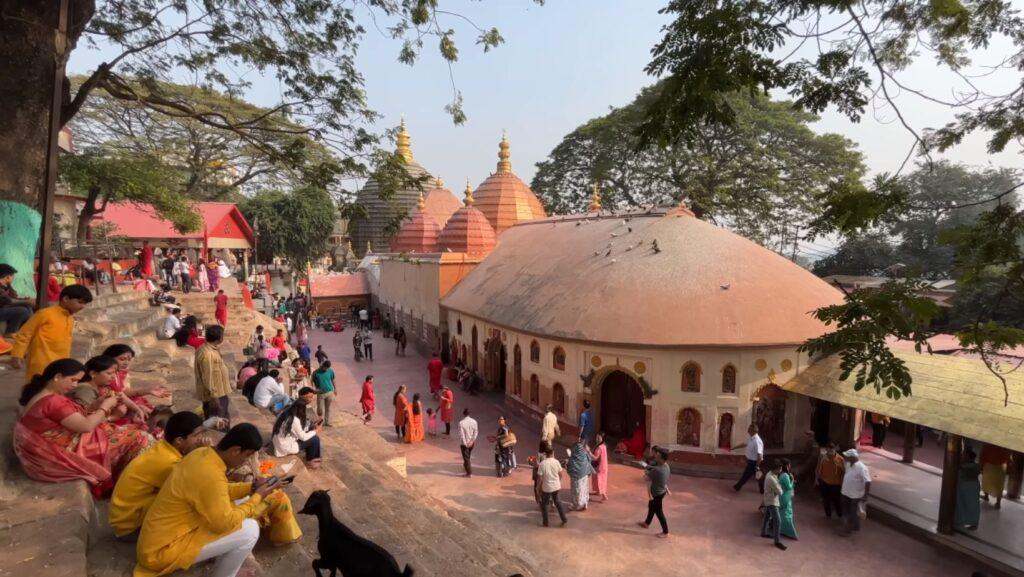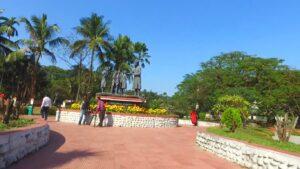About Kamakhya Temple
Kamakhya Temple, perched on the Nilachal Hill in Guwahati, Assam, is a historic and mystical sanctuary that has drawn devotees for centuries. This temple is dedicated to Goddess Kamakhya, an embodiment of Shakti, and is revered as one of the 51 Shakti Pithas in Hinduism. The site is deeply associated with the Shaktism and Tantric sects of Hinduism, making it a significant center for these practices.
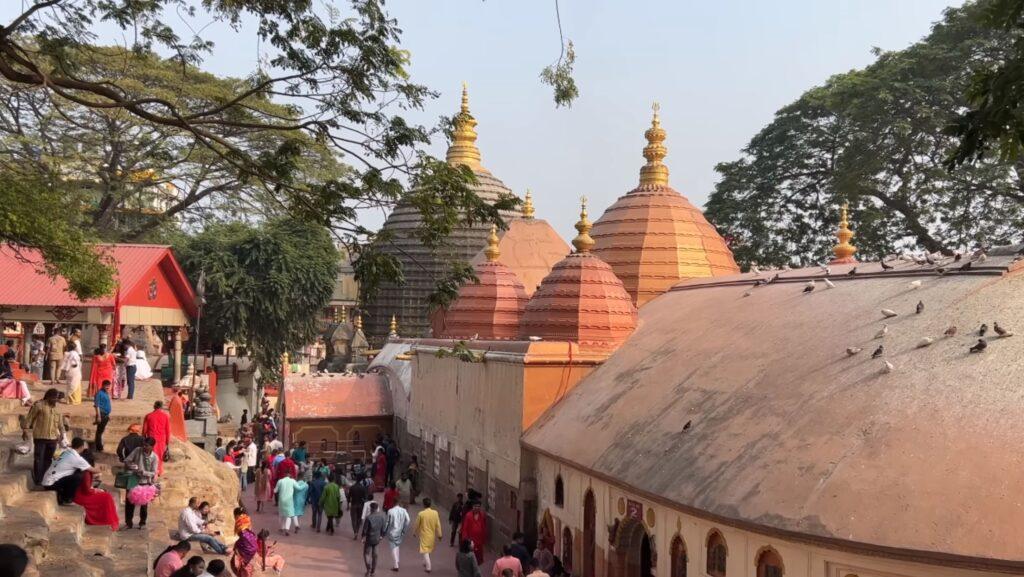
Architectural Details
The temple’s architecture is a testament to the various dynasties that have left their mark on this sacred ground. The main temple structure, with its beehive-like shikhara, is a fine example of the Nilachal style of temple architecture.
History of Kamakhya Temple
Mythological Origins
Kamakhya Temple is deeply rooted in the celestial tale of Goddess Sati. It is believed to be the hallowed ground where Sati’s yoni descended as Lord Shiva mourned her demise. Pivotal moment sanctified the temple grounds, symbolizing the essence of feminine dynamism and fecundity.
Architectural Heritage
Temple’s architectural lineage bears witness to the myriad dynasties that have sculpted its destiny. The primary edifice, harking back to the 8th-9th centuries, is distinguished by the Nilachal architectural motif, marked by its dome-shaped shikhara. Temple has undergone numerous restorations, with notable enhancements from the Koch and Ahom monarchs, who fused local artistry with classical Hindu temple architecture.
Cultural Resonance
More than a pilgrimage destination, Kamakhya Temple is a bastion of Tantric rites. The annual Ambubachi Mela, commemorating the goddess’s menstrual cycle, beckons a global congregation of the faithful. The temple’s chronicles are also intertwined with its stature as a symbol of regional sovereignty, having garnered patronage from the Mlechchha dynasty of Kamarupa, succeeded by the Palas, the Koch, and the Ahoms. The Kalika Purana, composed during the Pala dynasty, further enshrined the temple’s eminence by associating Naraka, the progenitor of the region, with Goddess Kamakhya.
Enduring Legacy
In contemporary times, Kamakhya Temple continues to thrive as a dynamic site of devotion, celebrating the enduring customs of Shaktism. Its storied past, spanning myriad generations, remains a source of inspiration for those in pursuit of spiritual awakening and a deeper communion with the divine feminine essence.
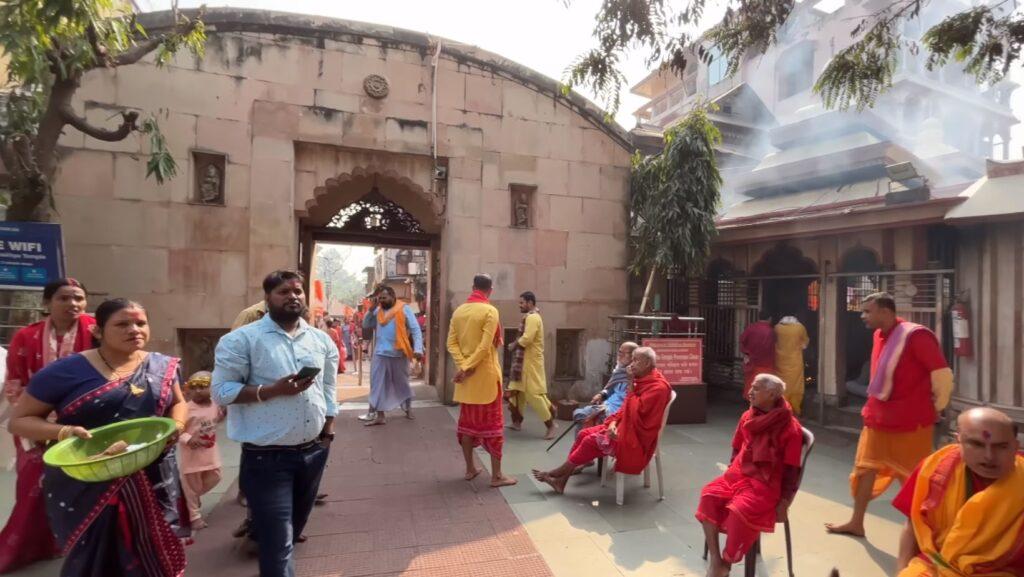
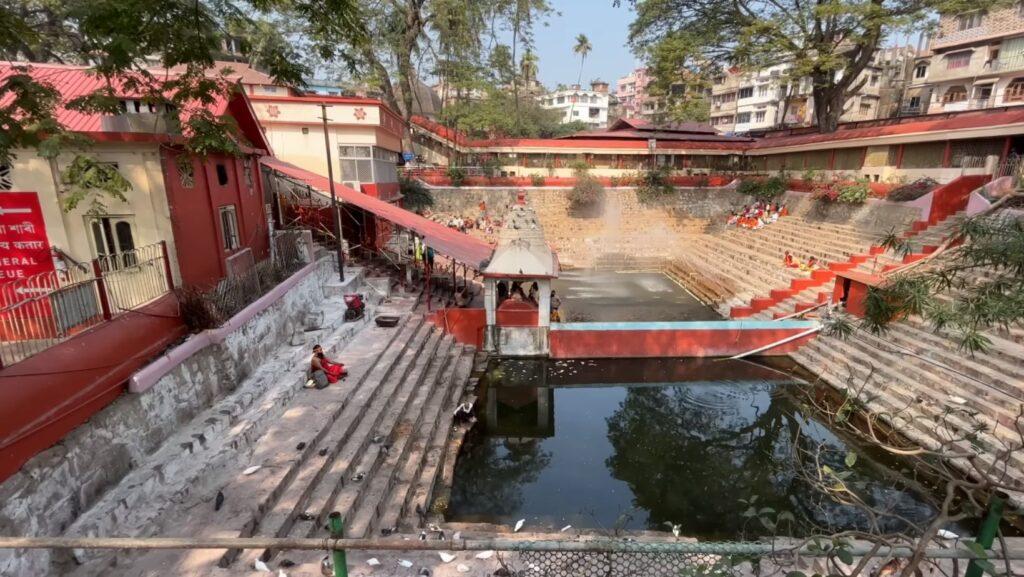
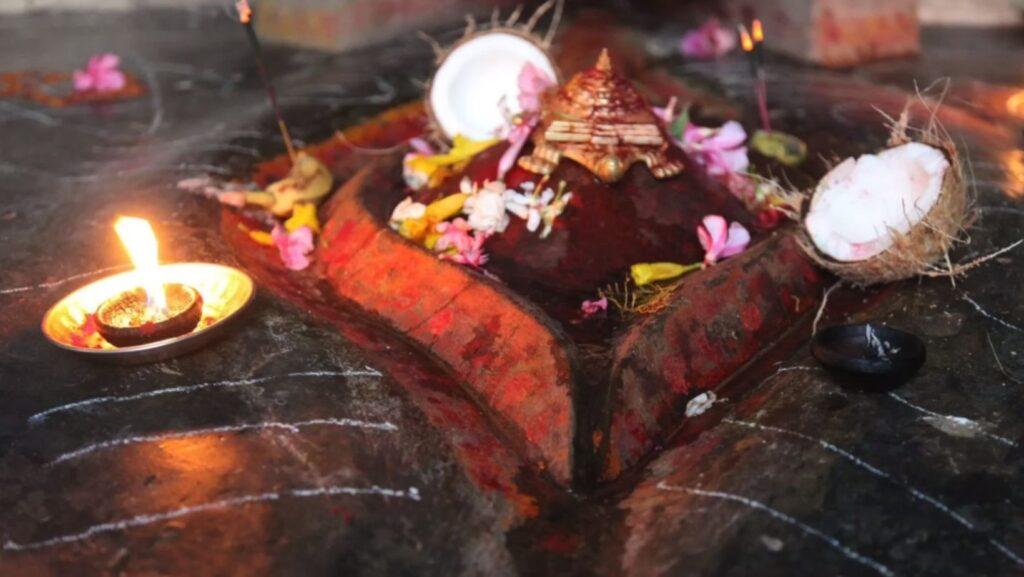
Architectural Marvel Kamakhya Temple
Kamakhya Temple is a fine example of Assam’s unique architectural style, blending Nagara (North Indian) and indigenous elements. The temple complex consists of multiple shrines, with the main sanctum dedicated to Goddess Kamakhya. Key architectural features include:
- Beehive-Shaped Dome: The main temple’s dome, or shikhara, resembles a beehive, a distinctive feature of Assamese architecture. It is adorned with intricate carvings and sculptures.
- Garbhagriha (Sanctum Sanctorum): Unlike most Hindu temples, the sanctum does not house an idol. Instead, it contains a naturally formed stone yoni, covered with a red cloth and adorned with flowers, symbolizing the goddess’s presence.
- Subsidiary Shrines: The complex includes smaller temples dedicated to other deities, such as the Dasa Mahavidyas (ten wisdom goddesses), Lord Ganesha, and Lord Shiva.
- Underground Chamber: The sanctum is located in a cave-like chamber, accessible via a series of steps. A natural spring keeps the stone moist, symbolizing fertility and divine energy.
The temple’s architecture reflects a harmonious blend of spirituality and craftsmanship, with intricate stone carvings depicting mythological scenes, floral motifs, and deities.
Religious and Cultural Significance
Tantric Worship
The Kamakhya Temple is one of the most important centers of Tantric Hinduism. Tantra, a spiritual tradition that emphasizes the worship of Shakti and esoteric rituals, finds a profound expression here. The temple’s rituals, including animal sacrifices (now less common due to ethical concerns), are performed with great reverence and secrecy. The sanctum’s yoni stone is believed to possess immense spiritual power, attracting Tantric practitioners and devotees seeking blessings for fertility, prosperity, and spiritual awakening.
Ambubachi Mela
The Ambubachi Mela, held annually during the monsoon season (usually June or July), is the temple’s most significant festival. It celebrates the goddess’s menstruation cycle, symbolizing the earth’s fertility. During this four-day event, the temple remains closed as the goddess is believed to be in her menstrual phase. Devotees throng the temple to participate in rituals, meditate, and seek blessings. The festival attracts sadhus, Tantric practitioners, and pilgrims from across India and beyond, making it a vibrant cultural and spiritual event.
Other Festivals
Apart from Ambubachi Mela, the temple celebrates festivals like Durga Puja, Navratri, and Manasa Puja with great fervor. These occasions see elaborate rituals, devotional music, and vibrant processions, adding to the temple’s spiritual vibrancy.
Temple Timings and Rituals
Daily Timings
The Kamakhya Temple is open to devotees and visitors throughout the year, with specific timings for darshan (viewing of the deity) and rituals. The general timings are:
- Morning: 5:30 AM to 1:00 PM
- Afternoon Break: 1:00 PM to 2:30 PM
- Evening: 2:30 PM to 10:00 PM
Note: Timings may vary slightly during festivals or special occasions. During Ambubachi Mela, the temple remains closed for three days, and darshan resumes on the fourth day.
Types of Darshan
- General Darshan: Free for all devotees, but it may involve long queues, especially during peak seasons.
- Special Darshan: Available for a nominal fee, offering quicker access to the sanctum.
- VIP Darshan: Arranged for dignitaries or through special permissions, subject to temple authorities’ discretion.
Daily Rituals
The temple follows a structured schedule of rituals, including:
- Morning Aarti: Performed at dawn to awaken the goddess.
- Bhoga Offering: Food offerings are made to the deity during the day.
- Evening Aarti: A grand ritual with lamps and chants to conclude the day’s worship.
Devotees are expected to maintain cleanliness, dress modestly, and follow the temple’s guidelines, such as removing footwear and avoiding non-vegetarian food on the premises.
Kamakhya Temple Best Time to Visit
Visiting the Kamakhya Temple, a revered shrine nestled atop the Nilachal Hill in Guwahati, Assam, is a spiritually enriching experience for many. To make the most of your pilgrimage or tour, it’s essential to choose the best time for your visit. Here’s a comprehensive guide to help you plan your journey:
Seasons and Weather
Winter (November to February):
- Temperature: Ranges from 10°C to 25°C during the day and can drop to around 5°C at night.
- Weather: Characterized by clear skies and low humidity, making it one of the best times for temple visits.
Spring (March to April):
- Temperature: Daytime temperatures range from 15°C to 30°C.
- Weather: The season is marked by clear skies and the blooming of vibrant flowers, offering a pleasant atmosphere for visitors.
Summer (May to June):
- Temperature: Daytime temperatures can soar from 25°C to 38°C.
- Weather: Evenings are cooler, but it’s advisable to carry light clothing and stay hydrated.
Monsoon (July to September):
- Temperature: Brings relief from the heat with temperatures between 25°C to 35°C.
- Weather: Heavy rainfall can lead to lush greenery, but the temple complex may get slippery.
Autumn (October):
- Temperature: Marks a transition with temperatures ranging from 20°C to 30°C.
- Weather: With clear skies and moderate temperatures, autumn is another excellent time for temple visits.
Best Time for Festivals and Spiritual Significance
- Ambubachi Mela (June/July): A significant festival that attracts devotees from all over.
- Durga Puja (September/October): Celebrated with great fervor, offering a unique cultural experience.
Tips for a Comfortable Visit
- Plan Ahead: Check the latest weather forecasts and temple schedules.
- Stay Hydrated: Carry water, especially during the warmer months.
- Dress Appropriately: Opt for comfortable and culturally respectful attire.
What is the historical significance of Kamakhya Temple?
Kamakhya Temple is one of the oldest and most revered centers of Tantric practices, dating back to the 8th-9th century. One of the oldest of the 51 Shakti Pithas in the Shakta tradition, where it is believed the goddess Sati’s yoni fell.
What are the daily timings for visiting Kamakhya Temple?
Temple is open for darshan from 8:00 AM to 1:00 PM and then from 2:30 PM to 5:30 PM.
How to reach Kamakhya Temple?
To Reach way to the Kamakhya Temple:
By Air:
Nearest airport is the Lokpriya Gopinath Bordoloi International Airport (GAU), located about 20 kilometers from the temple. It connects Guwahati with major cities in India and some international destinations. Upon arrival, you can hire a taxi or opt for bus services to reach the temple.
By Train:
Guwahati Railway Station (GHY) is the primary railhead serving the city and is approximately 8 kilometers from the temple. It’s a major hub with trains connecting to various parts of India. From the station, taxis, auto-rickshaws, and buses are available to take you to the temple.
By Bus:
Inter-State Bus Terminal (ISBT) in Guwahati is around 11 kilometers from the temple. Assam State Transport Corporation (ASTC) and several private operators run buses to Guwahati from neighboring states and cities. Local buses, taxis, and auto-rickshaws can be taken from ISBT to the temple.
By Taxi:
Taxis are readily available throughout Guwahati and offer a comfortable ride to the temple. You can also use app-based cab services for a hassle-free experience.
Local Transport:
For those already in Guwahati, local transport like auto-rickshaws and cycle-rickshaws provide an economical and authentic way to reach the temple.
Distance Considerations:
- From the airport to the temple: Approximately 20 kilometers.
- From the railway station to the temple: Approximately 8 kilometers.
- From ISBT to the temple: Approximately 11 kilometers.
Nearby Attractions
While visiting the Kamakhya Temple, explore these nearby attractions in Guwahati:
- Umananda Temple: Located on Peacock Island in the Brahmaputra River, dedicated to Lord Shiva.
- Assam State Museum: Showcases Assam’s rich cultural and historical heritage.
- Brahmaputra River Cruise: Offers scenic views and a relaxing experience.
- Pobitora Wildlife Sanctuary: A short drive from Guwahati, known for its one-horned rhinoceros.
Tips for Visitors
- Dress Code: Wear modest clothing, covering shoulders and knees. Traditional attire like sarees or salwar kameez is preferred for women.
- Footwear: Shoes must be removed before entering the temple. Facilities are available to store them.
- Crowd Management: Expect long queues during festivals. Opt for special darshan to save time.
- Photography: Photography is prohibited inside the sanctum but allowed in the outer areas.
- Accommodation: Book hotels in advance, especially during Ambubachi Mela, as Guwahati sees a surge in visitors.
- Local Etiquette: Respect the temple’s customs, avoid loud conversations, and follow the priests’ instructions.
Kamakhya Temple in Guwahati. Immerse yourself in its storied past, observe the sacred rituals, and choose the perfect time for an experience that resonates with your soul. Don’t wait any longer; plan your pilgrimage to this divine sanctuary today and be part of a timeless tradition!
